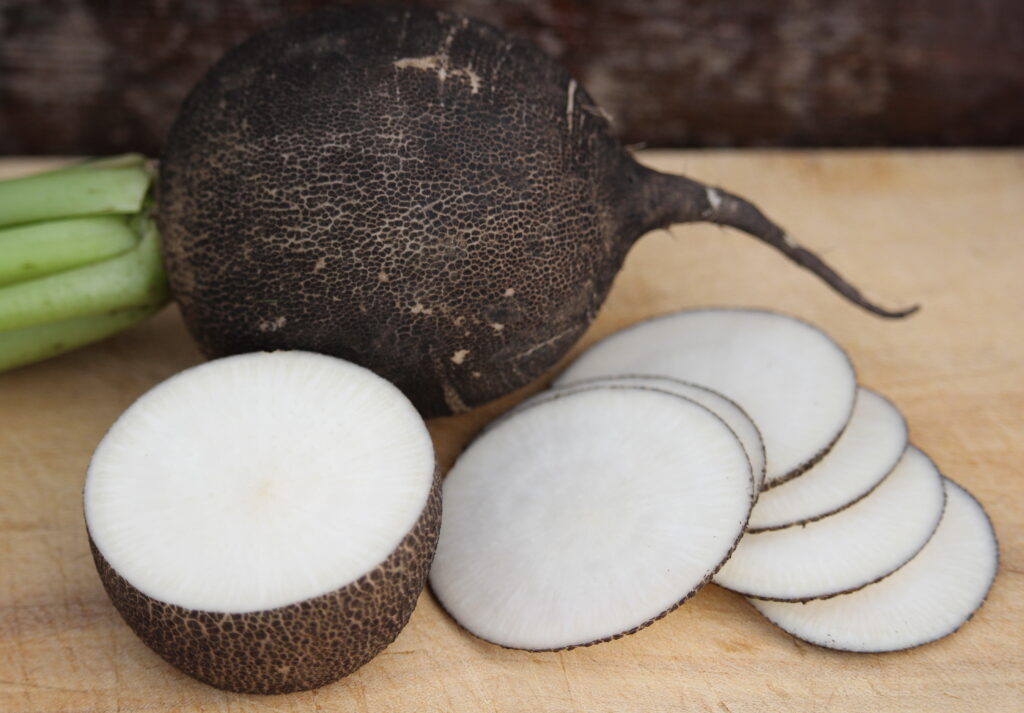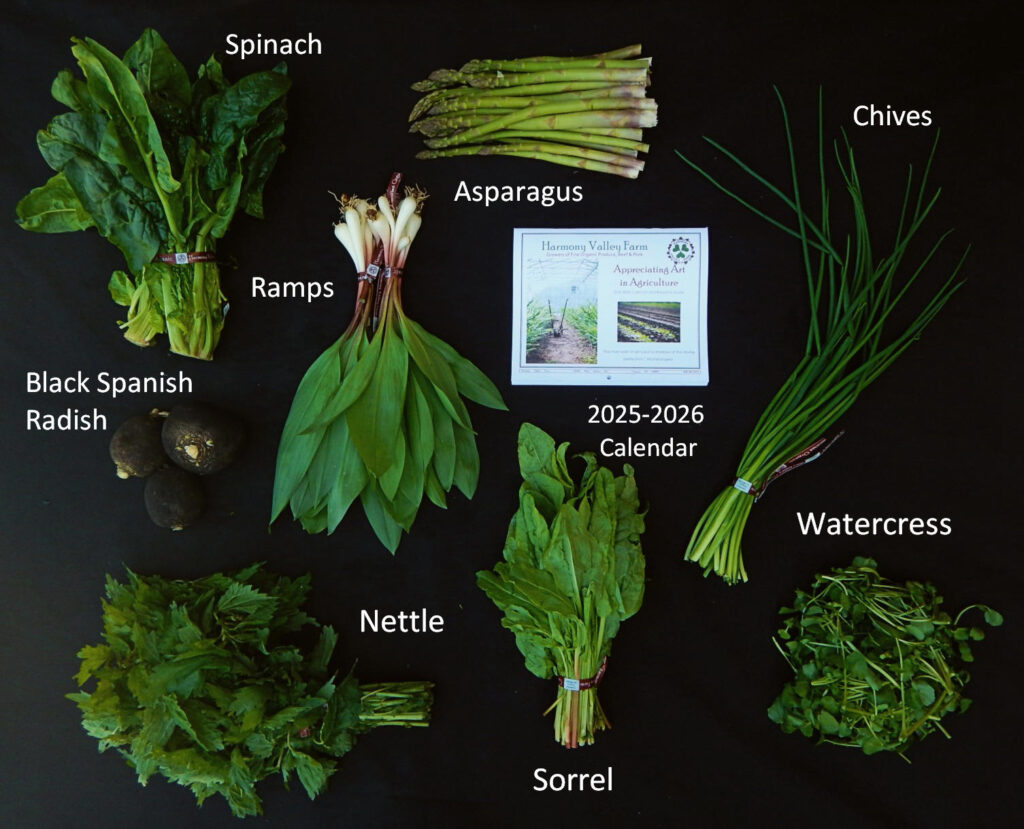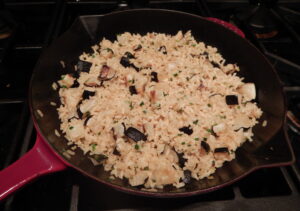What’s In The Box with Recipe Suggestions
Wild Ramps: This is a wild-harvested vegetable with delicate green, lily-like leaves, and an onion-like bulb on the bottom. The whole plant is edible, from the leaves to the bulb, but trim away the root end. Ramps have a distinct flavor that is stronger when eaten raw and mellows with cooking. Wrap ramps in a damp paper towel and place them in a plastic bag and store them in the refrigerator. Eat them within a few days as the leaves are delicate.
Nettle & Mushroom Pizza with Ramp Cream
Chives: Blend chives with olive oil, salt, and pepper to make a thick puree that can be stirred into sour cream, mayonnaise, or yogurt to make dips, spreads, or creamy dressing. You can also use the chive purée to top off grilled steak or roasted chicken.
Parmesan and Chive French Toast
Sorrel: Sorrel is a bunched green with arrow shaped leaves. It has a tangy, citrus flavor and may be eaten raw or cooked. When cooked, the leaves turn olive green and soften to the point where they melt into a sauce like texture that is lovely in soups and sauces.
Watercress: This item is bagged in a clear Ziploc bag. We recommend giving it a quick wash before eating. You may eat the leaves and the stems, either raw or cooked. It is a peppery green that grows wild at the head of natural springs. The peppery flavor mellows when cooked.
Spring Soba Noodle Salad with Crispy Tofu
Broiled Bacon-Wrapped Chicken with Sweet Potatoes and Watercress
Nettles: Important Information—The nettles are bunched together and packed in a plastic bag. They do have little hairs on the stems that can cause a sting when you touch them. Most of the sting is removed with washing, but to be on the safe side we’ve put them in a bag for you. When you are ready to use them, use tongs (or wear gloves) to handle them and always cook them before eating them. If you put them in boiling water for just 30-45 seconds or so, the sting will completely go away. After 30-45 seconds, remove them from the boiling water and run under cold water. Squeeze out the excess water and then take the leaves off the main stem. Discard the stem and use the leaves.
Check out a previous blog post which demonstrates these processes and includes pictures
Nettle & Lemon Cupcakes with Lavender Icing
Asparagus: Brush asparagus spears lightly with oil and toss them on the grill or roast in the oven. Serve them with a squeeze of lemon and grated cheese for a super-simple side dish.
Asparagus Goat Cheese and Lemon Pasta
Overwintered Spinach: Planted in the fall and harvested this spring, this spinach has a unique sweetness. The leaves are thick, yet tender. You may eat spinach raw or cook it. Store spinach in the bag and keep it in the refrigerator.
Spring Spinach Chop Salad with Creamy Buttermilk Ramp Dressing
Black Spanish Radishes: These are the round, black roots in your box. The skin is supposed to be black and when you cut into these radishes, you’ll find dense, white flesh with a pungent radish flavor when eaten raw. A traditional way to enjoy this radish is to shred or slice thinly and soak for about 15-20 minutes in salted water. Drain, rinse and pat dry; mix in with sour cream and serve with chewy rye bread. Store them in the refrigerator.
Black Spanish Radish & Apple Slaw with Honey Vinaigrette
Roasted Black Radishes with Brown Butter, Chives & Rice
Vegetable Feature: Black Spanish Radishes

Black Spanish Radishes are an intriguing root vegetable with some unique attributes. For starters, they are one of the very few vegetables that are supposed to be black! They have a charcoal black skin which is a stark contrast to the snow-white flesh inside. They are classified as a winter storage radish and may be stored for months. We actually harvested these last fall and have been holding them in our cooler for nearly seven months! Because of their long storage potential, they are used more by people in colder climates such as northern Europe where they are an important winter food. Black Spanish Radishes are in the Brassicas family, a class of vegetables known to have a wealth of beneficial nutrients. They are unique in that they have the highest levels of a phytonutrient called glucosinolate. This nutrient plays an important role in supporting the liver in its role in detoxifying the body of toxins. If you are interested in more of the science about how this phytonutrient works in our bodies, there is an interesting article at www.wholisticmatters.com/Spanish-blackradish-whats-old-is-new-again.
Black Spanish Radishes may be eaten either raw or cooked. When eaten raw, they have a stronger flavor with a peppery bite that is similar to horseradish. They can be added to fresh vegetable or grain salads, sliced thinly, and added to sandwiches, or eaten raw with creamy dips. Slicing these radishes thinly so the flavor is not too overwhelming, will make for a more enjoyable eating experience. These radishes are also delicious when fermented or made into kim chi. If you do not care for a strong radish flavor, you may enjoy Black Spanish Radishes more when cooked, which helps to mellow out their flavor. They may be roasted, added to soups & stews, stir-fried or sautéed. There are a lot of beneficial nutrients in the skin, so we recommend leaving the skin on. Store Black Spanish Radishes in the refrigerator in a plastic bag or wrapped in a towel to keep them firm until you are ready to use them. They will store for quite a while, but we encourage you to use these within the next 3-4 weeks for best results.
Short & Sweet Weekly Farm Update

Welcome to the 2025 CSA season! We do still have room to accept more CSA members, so please let your friends and neighbors know they can still get in on all of the fun and good eats yet to come in 2025! Have fun cooking and eating your way through the first box. We’re glad you made the decision to eat through the midwestern growing season with us this year! Our season is off to a good start, despite some weather and late crew challenges. Most of the crew is now here on the farm and boy are we are all excited to see their faces!
With April showers bringing May flowers, we actually have seem quite a bit of rain in April so far. This week we are anticipating clear (mostly clear) skies, and our rock-star team is making great progress in keeping our planting done, complete harvests, cultivation, etc. all on task.

We struggled to get the onions/shallots to the field in April, which made the greenhouse space for warm weather crops (melon/watermelon/winter squash) really tight! We now have cole crops, Kohlrabi, broccoli, cauliflower, cabbage, and kales transplanted to the fields and starting to grow. Also, Celeriac, parsley, fennel, and lettuce newly transplanted. Grown from seed, planted in the field in April (by Rafael) is baby Arugula, 2 inches tall already. The salad and spinach are not far behind. Today the planting crews were planting sweet corn, beans, and peas. We are also already seeing beets, carrots, parsnips, and chard starting to break through the soil!
Our cultivation crew has been busy with cilantro, dill, and radishes plantings. After cultivating them, we put a protective row cover on them to stave off flea beetles. “Pretty darn amazing what our skilled and motivated crew can do in a week of dry weather” says Richard.






2 Responses
As a brand new member, I appreciate the description of what each produce looks like and how to prepare it. Since I’ve never eaten several of them, the recipes will help me integrate into my meals. Thank you!
I’m liking these newsletters on (what appears to be) a new site design. We share our share with another family and I’m not the primary contact for our family, so if this isn’t actually new it’s at least new to me. Gotta say, I was pretty nervous on Thursday when I went to the the blogspot site and and found it didn’t have an update for our first box of the year, but I was relieved to find this new format with the same helpful box explainer and recipe suggestions. It’s one of the things I appreciate the most about our share. In my opinion it’s the best thing for ensuring we can create a plan for all the contents so they don’t go to waste, and typically the recipes have so many unique suggestions that I would never think of otherwise. Looking forward to another delicious year.